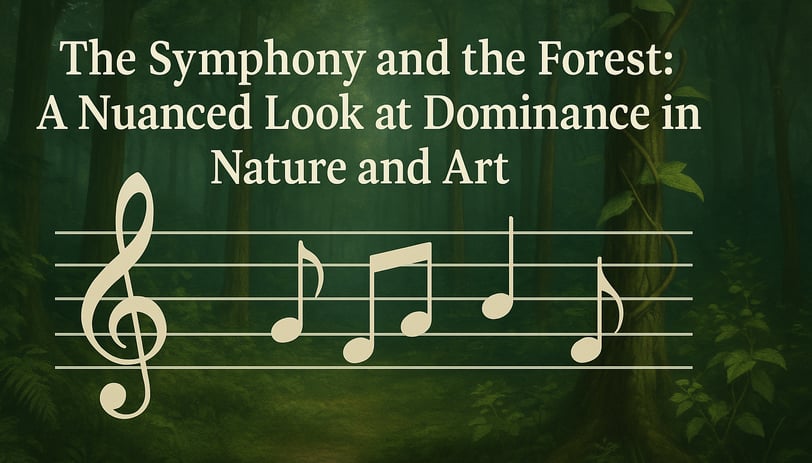The Symphony and the Forest: A Nuanced Look at Dominance in Nature and Art
Explore the interplay between nature and music in this thought-provoking blog, "The Symphony and the Forest." Discover how dominance manifests in ecosystems and artistic compositions, from birdsong to orchestral crescendos. A perfect read for nature lovers, musicians, and creatives alike. Dive into the harmony and competition that shape both forest life and soundscapes.
Byron Lacy
6/25/20253 min read


Nature doesn’t just surround us—it speaks to us. Through sight and sound, the wild offers profound metaphors for human creativity, especially when it comes to the idea of dominance. But what does dominance mean in the context of a rainforest or a string quartet? Can a crashing wave or a bird’s cry tell us something about music, art, and the structure of expression?
Let’s take a journey into the visual and auditory worlds of nature and explore how they intersect—and diverge—with the human pursuit of artistic mastery.
🌿 The Forest Floor: A Visual Symphony of Coexistence
In the visual realm, nature—especially in forest ecosystems—often presents an image of balance and cooperation. Trees, shrubs, fungi, and mosses engage in a quiet battle for sunlight, water, and nutrients. Yet the result isn't usually destruction, but diversity. Each species finds its place, growing into its niche without obliterating its neighbors.
The forest floor becomes a living mosaic, where every layer—from the highest canopy to the soil's microbial universe—interacts in intricate, interdependent ways. Light is filtered, nutrients are recycled, and space is shared.
But not all is peaceful. Parasitic plants like kudzu or poison ivy break the code. These species don’t play by the forest’s rules of balance—they dominate, often choking out other plants completely. Their aggressive tactics offer a glimpse of dominance as destruction—a rare but real counterpoint to the harmony that usually reigns.
🔊 Nature’s Soundscape: Presence Without Competition
Shift your focus to your ears. The auditory world of nature feels different. Unlike trees that compete for space, sounds don’t fight for territory. The wind rustling through leaves, the rain's rhythm on soil, the thunder rumbling through mountains—these are not acts of competition. They are byproducts of energy, of movement, of natural processes.
These sounds coexist easily. A waterfall doesn’t try to outdo the birdsong; it simply exists. Its loudness is not a boast, but a function of its force.
What emerges is a soundscape, not a battlefield. And this raises an interesting contrast with how we, as humans, often structure sound—especially in music.
🐦 Birds and the Battle for Sonic Space
But there is competition in nature’s sound world—especially when it comes to animal vocalizations. Birds, in particular, engage in acoustic duels every morning. Males sing to claim territory, to impress mates, to warn rivals. Their songs aren't just beautiful—they're strategic.
Birds develop complex, unique calls. Some evolve louder pitches to cut through dense foliage. Others repeat phrases to show stamina. And while species often avoid direct interference with each other’s songs, their goal is still clear: to stand out, to be heard, to dominate the soundscape in their corner of the forest.
This is where natural sound starts to align with music—it has intent, structure, and purpose.
🎶 From Nature’s Noise to Music’s Meaning
In music, dominance isn’t accidental—it’s crafted. A composer chooses what leads and what follows. Dynamics (loud and soft), timbre (texture), rhythm, and harmony are used like tools to create emphasis, emotion, and hierarchy.
A thunderclap may inspire a dramatic crescendo in an orchestral piece. A bird’s call might echo in a solo flute line. But in music, every sonic choice is intentional. The dominant voice isn’t the loudest by chance—it’s placed there to guide the listener, to anchor the narrative.
In contrast to nature’s unstructured brilliance, music transforms raw sound into artful order.
🧠 Final Thoughts: Art Imitates and Elevates Nature
What can we learn from this comparison?
In the visual world, dominance often gives way to harmony and coexistence.
In the auditory wild, we find both randomness (thunder, wind) and rivalry (birdsong).
And in music, we see dominance as a deliberate, creative choice, echoing nature but also elevating it into a form that carries human meaning.
Nature doesn’t compose symphonies. But it does whisper ideas, hum patterns, and crash with emotion. As artists, musicians, and observers, it’s up to us to listen, translate, and transform these echoes into expressions that are uniquely human—yet deeply rooted in the wild.
Contacts
Support@thebyronlacy.com
Socials
Subscribe to our newsletter
+1-9365532306
Website Design by Filtershots
